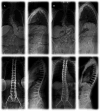Why Didn't You Walk Yesterday? Factors Associated With Slow Early Recovery After Adult Spinal Deformity Surgery
- PMID: 37614144
- PMCID: PMC11877673
- DOI: 10.1177/21925682231197976
Why Didn't You Walk Yesterday? Factors Associated With Slow Early Recovery After Adult Spinal Deformity Surgery
Abstract
Study design: This is a retrospective case-control study.
Objectives: The objectives of this study are to identify (1) risk factors for delayed ambulation following adult spinal deformity (ASD) surgery and (2) complications associated with delayed ambulation.
Methods: One-hundred and ninety-one patients with ASD who underwent posterior-only fusion (≥5 levels, LIV pelvis) were reviewed. Patients who ambulated with physical therapy (PT) on POD2 or later (LateAmb, n = 49) were propensity matched 1:1 to patients who ambulated on POD0-1 (NmlAmb, n = 49) based on the extent of fusion and surgical invasiveness score (ASD-S). Risk factors, as well as inpatient medical complications were compared. Logistic regressions were used to identify risk factors for late ambulation.
Results: Of the patients who did not ambulate on POD0-1, 32% declined participation secondary to pain or dizziness/fatigue, while 68% were restricted from participation by PT/nursing due to fatigue, inability to follow commands, nausea/dizziness, pain, or hypotension. Logistic regression showed that intraoperative estimated blood loss (EBL) >2L (OR = 5.57 [1.51-20.55], P = .010) was independently associated with an increased risk of delayed ambulation, with a 1.25 times higher risk for every 250 mL increase in EBL (P = .014). Modified 5-Item Frailty Index (mFI-5) was also independently associated with delayed ambulation (OR = 2.53 [1.14-5.63], P = .023). LateAmb demonstrated a higher hospital LOS (8.4 ± 4.0 vs 6.2 ± 2.6, P < .001). The LateAmb group trended toward an increase in medical complications on POD3+ (14.3% vs 26.5%, P = .210).
Conclusions: EBL demonstrates a dose-response relationship with risk for delayed ambulation. Delayed ambulation increases LOS and may impact medical complications.
Keywords: adult spinal deformity; ambulation; blood loss; delayed; spinal fusion.
Conflict of interest statement
Declaration of Conflicting InterestsThe author(s) declared no potential conflicts of interest with respect to the research, authorship, and/or publication of this article.
Figures

Similar articles
-
Timing of inpatient medical complications after adult spinal deformity surgery: early ambulation matters.Spine J. 2023 Feb;23(2):219-226. doi: 10.1016/j.spinee.2022.09.001. Epub 2022 Sep 22. Spine J. 2023. PMID: 36152773
-
Effects of delayed ambulation following posterior spinal fusion for adolescent idiopathic scoliosis: a single institutional study.Spine Deform. 2023 Sep;11(5):1127-1136. doi: 10.1007/s43390-023-00693-y. Epub 2023 Apr 24. Spine Deform. 2023. PMID: 37093449
-
Safety and benefit of ambulation within 24 hours in elderly patients undergoing lumbar fusion: propensity score matching study of 882 patients.Spine J. 2024 May;24(5):812-819. doi: 10.1016/j.spinee.2023.11.014. Epub 2023 Dec 9. Spine J. 2024. PMID: 38081459
-
Association between delayed ambulation and increased risk of adverse events after lumbar fusion surgery in elderly patients.BMC Musculoskelet Disord. 2024 Jun 27;25(1):501. doi: 10.1186/s12891-024-07606-8. BMC Musculoskelet Disord. 2024. PMID: 38937718 Free PMC article.
-
Pediatric cervical kyphosis in the MRI era (1984-2008) with long-term follow up: literature review.Childs Nerv Syst. 2022 Feb;38(2):361-377. doi: 10.1007/s00381-021-05409-z. Epub 2021 Nov 22. Childs Nerv Syst. 2022. PMID: 34806157 Review.
References
LinkOut - more resources
Full Text Sources

